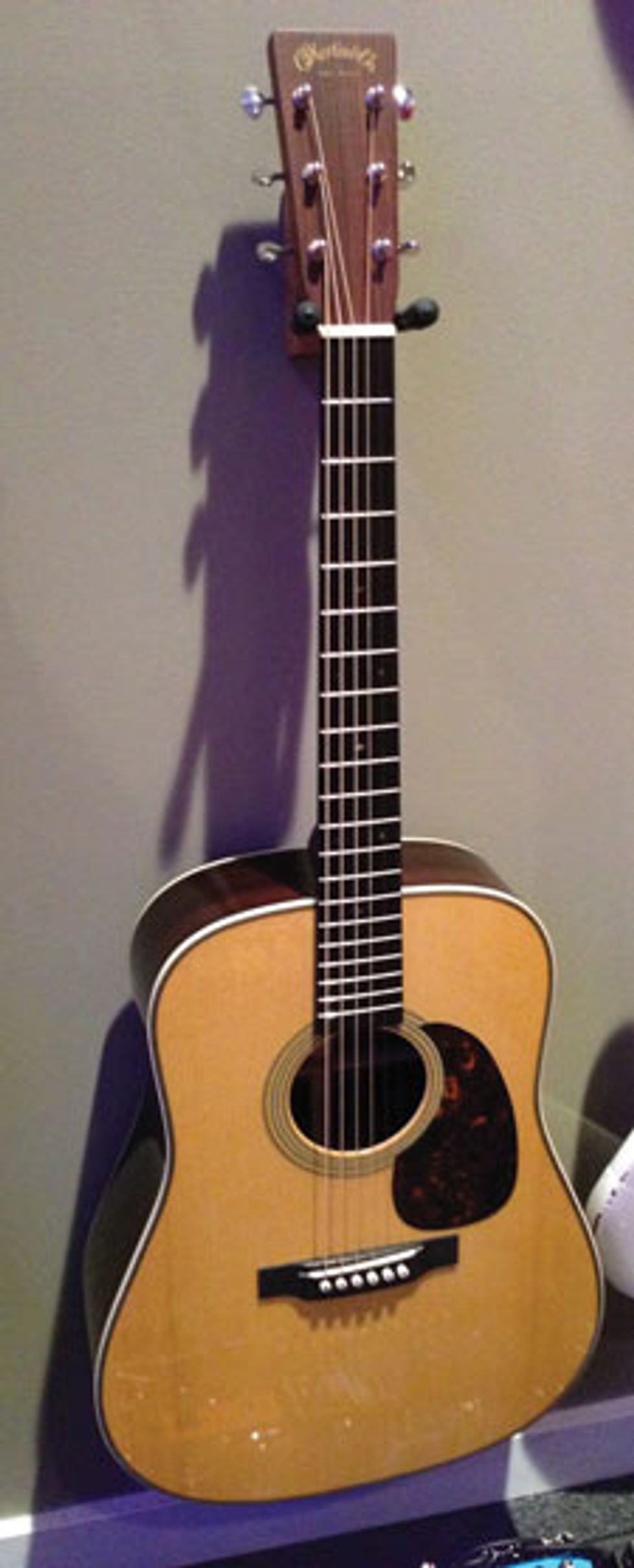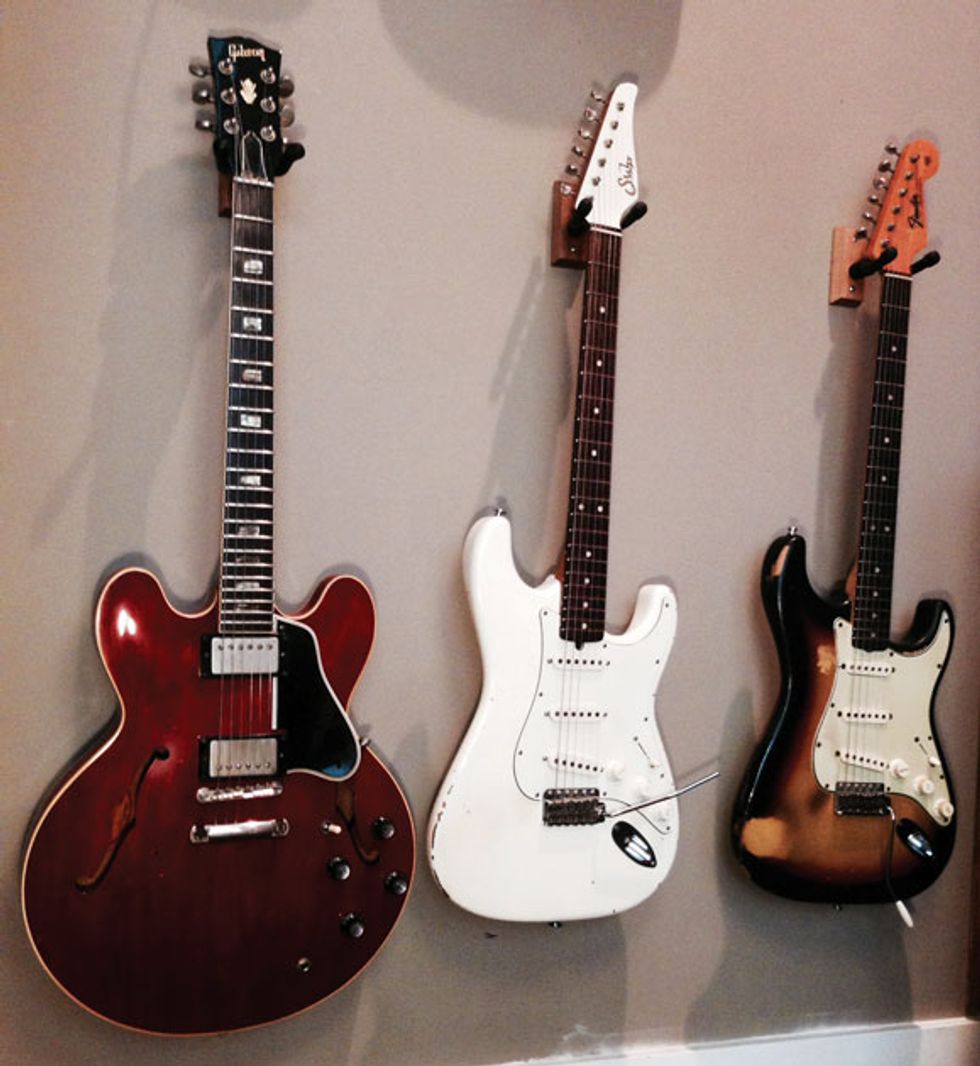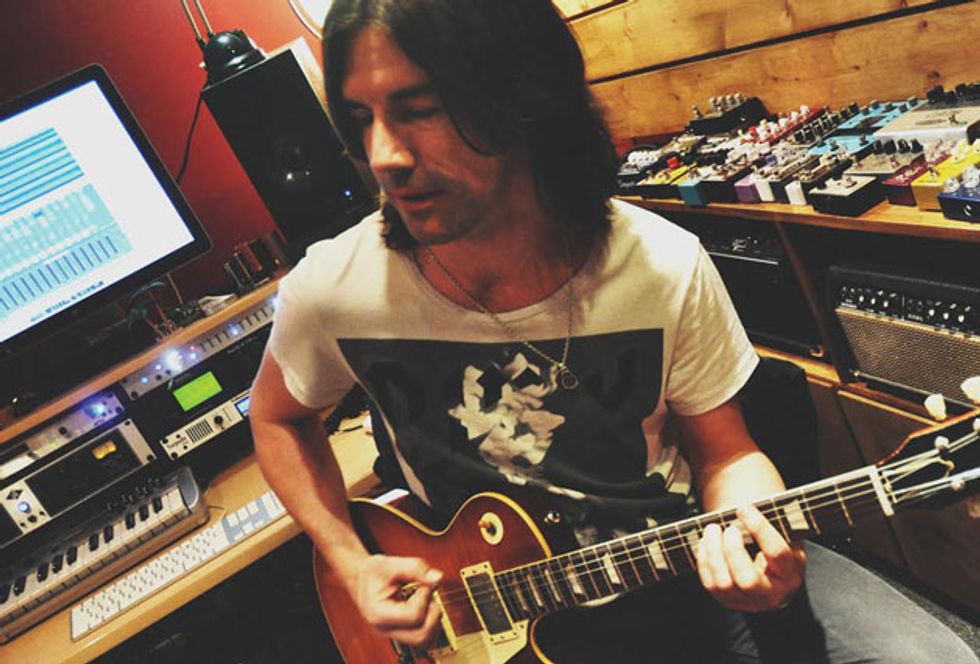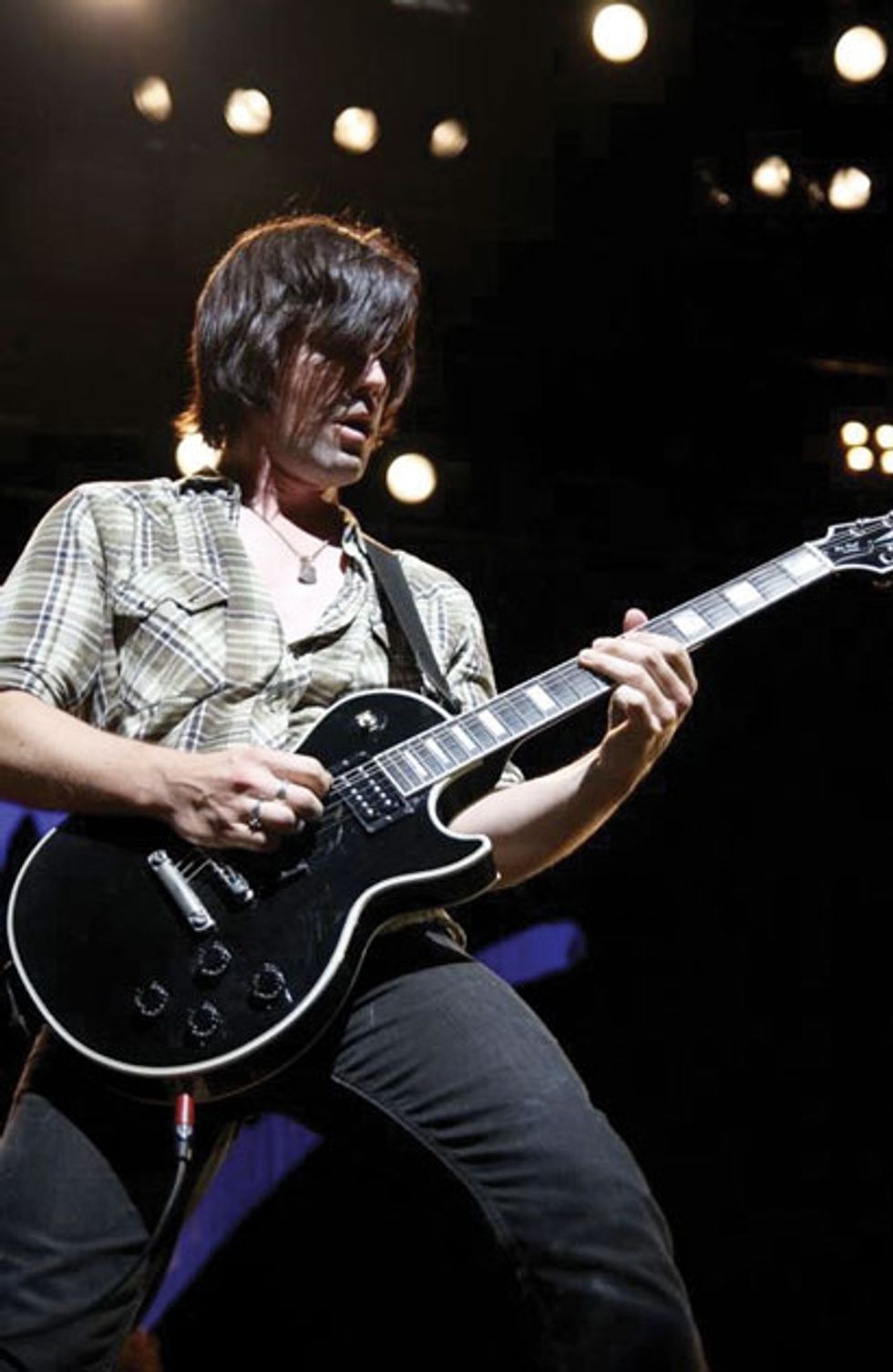Being a well-rounded sideman and session player requires more than just a couple of guitars.
Peter Thorn’s tools include a 1963 Gibson ES-335, a 2011 Suhr Classic S, and a 1964 Fender Stratocaster.
Like most of you, I’m absolutely intrigued by gear and how it’s used in musical contexts. The gear choices we make stem from many things, but my main concerns are tone and functionality: How well does the gear get the job done? Still, aesthetics and ease of use are also important because the guitars we choose are vehicles for our expression. I’m going to walk you through my main guitars, offer some simple advice, and discuss the mods I’ve made to my axes to make them more functional.
Tools of the Trade
First and foremost, guitars are tools to me. I need them to do my job. I do have a real fondness for particular instruments in my collection, but I can honestly say that I’m not afraid to take vintage guitars out on tour, and I don’t get upset if guitars get dinged or scratched. They are meant to be played, and ultimately, it’s all about what you create with the tools, not the tools themselves.
I’m no purist. I like vintage guitars, but I don’t mind if they’re modified for improved tone, playability, or functionality. I also like new instruments that are crafted to high standards and believe they can often match or exceed the tone of the best vintage instruments. If a vintage guitar sounds great, there are quantifiable reasons why, and these things can be measured and ultimately recreated in new instruments. My friend John Suhr once said to me, “They didn’t use magic trees.”
The Well-Rounded Collection
Because I make my living mainly as a sideman and session player, I require a well-rounded guitar collection. I often need to reproduce many distinct tones within one set. When I was touring with Chris Cornell, for example, we would perform material spanning his entire recording career. So within one show, I needed the Hendrix-y Strat tones of Temple of the Dog’s Mike McCready, the somewhat cleaner and sometimes effected tones of Audioslave’s Tom Morello, the varied sounds from Cornell’s three solo albums, and of course the sludgy, dark, and downtuned tones of Soundgarden. My guitar choices are born of necessity.
Fender-Style Guitars
I first started playing around 1981 on a Strat copy. Because of this, Stratocaster-style guitars and their 25 1/2" scale and body contours will always feel like home. I have a terrific 1964 Strat that sounds warm and ballsy, yet also clear and airy. It has a few mods, because again, I view guitars as tools.
My ’64 has been refretted with Dunlop 6105 fretwire and outfitted with a 5-way pickup-selector switch. The bottom tone pot has also been wired to work on the bridge pickup. This is a great mod for Strats because the often ice-picky bridge pickup can be tamed to match well with the neck and middle pickups. I also removed the string tree, which helps the guitar stay in tune, though it requires that I wind the 1st and 2nd strings quite far down the tuner posts.
I’ve toured with the old Strat quite a bit, although I’ve been leaving it at home lately. These days, when I need that Strat tone and feel, I use one of several Suhr Classic S guitars. They play and sound like good vintage Strats, but with all the quirks fixed. My Classic S guitars have floating Gotoh 510 tremolo bridges, compound-radius fretboards with stainless-steel frets, and Suhr’s noiseless system that eliminates 60-cycle hum without changing the tone of the guitars. All this makes for an extremely easy to play and great-sounding Strat-style guitar.
Two of my Classic S guitars have the traditional arrangement of three single-coils using Suhr V60LP pickups, while my sunburst Classic S has a single/single/humbucker setup. I have a push-pull tone pot on this guitar set to switch the Suhr SSH bridge humbucker from standard series operation to parallel. This too is a great mod, since a humbucker in parallel sounds very close to a single-coil. (“Tapping” a humbucker for single-coil operation has always sounded somewhat fake to me, so I much prefer the series/parallel switch.)
My Classic S with the humbucker is probably my most versatile guitar—if I had to bring just one axe to a gig, it would most likely be this one. I recommend that anyone in my line of work own at least one good Strat-style guitar with a single/single/humbucker pickup arrangement. It’s as close to a jack-of-all-trades electric guitar as you can get.
I also have a Suhr Classic T Antique, a ’50s Tele-style guitar. A good Tele-style axe is an absolute necessessity for sideman or session work. They are incredibly versatile for such a simple design, and sometimes you simply have to have that Tele-style tone and look.
Thorn in the studio with the ’59 replica built for him by luthier Gil Yaron. He believes modern instruments made to the highest standards can match or exceed vintage instruments. Photo by Ray Guiterrez.
Gibson-Style Guitars
Getting used to Gibsons and Gibson-style guitars was an adjustment for me. The way they hang on a strap on my body, the increased neck angle, and the height of the Tune-o-matic bridge all took some getting used to. They now generally feel very comfortable, which is great, because I often need to have the thicker midrange and sustain that only a Les Paul can provide. And a 335 or similar semi-hollow axe can be a beautiful thing for certain situations as well. When it comes to three-on-a-side headstocks, rosewood fretboards, humbuckers, and a 24 3/4" scale length, I have three main squeezes.
My 1963 Gibson ES-335 is the real deal. Played by Eric Clapton with Cream, Eric Johnson, and too many other legends to mention, a 335 has warmth and air around the notes—and when plugged into a cranked amp, it screams. A good 335 or similar semi-hollow guitar is a big asset for any touring sideman or session player because these guitars sound wonderful and look great to boot. I sometimes stuff foam or deadening material into the soundholes, which can really help cut down on the feedback that semi-hollow guitars are prone to.
Thorn on tour with Chris Cornell—and the 2002 Les Paul Custom he calls his “rock ’n’ roll machine.”
Photo by Hugo Marcotte.
The black 2002 Les Paul Custom that I call my “rock ’n’ roll machine” is a total road warrior with a deep, powerful, and clear tone. I used it extensively on tour with Chris Cornell, and it was my main guitar for Soundgarden material. When I was on tour with Melissa Etheridge, she often borrowed it, and liked it so much that she eventually bought her own black LP Custom.
My LP Custom has had a headstock break, and the electronics and pickups have been switched out. I often switch out the pots on modern Les Pauls since Gibson usually ships them with 300k linear-taper pots, which I find to be muddy sounding. I prefer 500k audio-taper pots because they open up the tone, and I prefer the audio taper. My LP Custom has a wiring harness from RS Guitarworks, a Seymour Duncan ’59 in the neck, and an old WB Habanero in the bridge. It’s just a solid, versatile Les Paul.
In 2012, Israeli luthier Gil Yaron made me a replica of a very coveted guitar from 1959 (yes, that one). I adore the thing. It plays and feels exactly like a great 60-year-old guitar should. The pickups sound warm, yet they have a beautiful, chimey, open top end—something I find lacking in most modern guitars of this type. Low- or low-to-mid output pickups are the name of the game here, as I find there’s always a way to get more gain, but it’s tough to get that magic, balanced sound once a pickup gets too hot. I’ve played numerous late ’50s bursts and goldtops, so I know what I like about those old guitars, and my Yaron captures that magic.

Thorn’s main acoustic is a 2012 Martin D-28 because of its effortless feel and stellar sound.
Acoustics
I have an absolutely beautiful GA8e-12 Taylor 12-string with their onboard Expression System, and I just can’t say enough about Taylor guitars in general. They sound lush, clear, and natural plugged in, play incredibly well, and are tough as nails. I can drop my GA8e-12 from standard tuning to D—a whole-step down—and it barely flinches. A small tweak of the truss rod is usually all that’s ever required.
My main 6-string acoustic is a 2012 Martin D-28, a gift from Chris Cornell. A D-28 is like the Chevy truck of acoustics: It just gets the job done. It plays effortlessly and has a B-Band A2.2 pickup/preamp system that consistently gets raves from front-of-house engineers. My Martin sounds incredibly natural with a very true acoustic sound—not hyped or typically piezo-like. For all my acoustics, I use an Ultra FBR2 Feedback Buster. It’s a rubber device that fits in the soundhole to stop unwanted feedback. I can’t recommend this easy little trick highly enough.
When on tour, the most important accessory in my guitar vault to keep my axes in top shape (besides strings and truss-rod wrenches) is Big Bends Nut Sauce. It’s a lubricant easily applied to the nut slots and bridge saddles on any guitar. Nut Sauce is an absolute necessity for me because it increases tuning stability dramatically, especially for Gibson-style guitars. I use it every time I change strings.
Well, that’s it. I make my living with the guitars I’ve detailed here 95 percent of the time. As you know now, I firmly believe that simple tweaks or mods can often make a great guitar even better, and I hope you’ve found some of my tips, tricks, and mod details helpful. Until next month, I wish you great tone!




